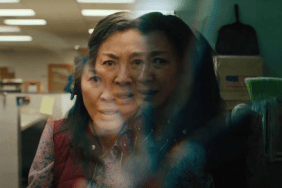
The splitting of Nymphomaniac into Nymphomaniac: Vol. I and Nymphomaniac: Vol. II is quite ridiculous and given the fact the two installments grossed just barely over one million combined in their limited theatrical run proves the commercial reasons are hard to make a case for. Not to mention, the way the film was marketed was only ever as some sort of a scandalous venture where, in fact, that’s hardly the case when it comes to the final product.
Anyone approaching Nymphomaniac with prurient interests will come away disappointed. Then again, even if you’re not looking for some sexed up, independent art film porno you might wish that’s what you’d gotten as writer/director Lars von Trier has delivered a talky, flashback-driven, voice over fueled picture of relative boredom with minor flashes of intrigue throughout.
Charlotte Gainsbourg stars as the titular sex fiend, real name Joe, and she’s found, beaten and bloodied, in a back alley at the beginning of the film by perennial bachelor Seligman (Stellan SkarsgÃ¥rd). Seligman offers her tea and his place where she can rest, clean up and in the process he urges her to tell him her story. Joe proceeds with clinical precision, as if narrating a BBC nature documentary. I’m no fan of voice over to begin with and Gainsbourg’s reading quickly begins to grate as if one character narrating a flashback-driven film that collectively runs 241 minutes wasn’t bad enough.
Making matters worse, amid her stories of youthful sexual exploration, Seligman finds it necessary to consistently interrupt with what he perceives to be useful and relevant metaphorical analysis, the worst of which being fly fishing metaphors (Salmong Fishing in the Yemen wasn’t this on the nose with its metaphors) so obvious I wanted to scream. He even brings the Fibonacci sequence of all things into the conversation very early on, which is when I realized this was a movie trying to be much smarter than it actually is, but I stuck with it against my greater desire to turn it off and never return.
Fortunately there were moments of excellence, none more impressive than the final “chapter” in Vol. I, titled “The Little Organ School” in which Joe and Seligman draw a comparison between Bach’s search for harmony in a term referred to as “polyphony” in which multiple musical textures come together to create harmony. Joe finds comparison in her sexual dalliances in how she was unable to be sated by merely one partner in a day, but within a combination of sexual appetites she found a balance that created a sexual symmetry of sorts.
Within this chapter von Trier finds a comparison between Joe’s sexual partners to the “voices” in one of Bach’s pieces. The aural and visual representation von Trier creates is wonderful, but he also finds a way to make the entire sequence overly convoluted with Seligman adding unnecessary detail such as the way the number values of the characters in Bach’s name (B=2, A=1, C=3, H=8) are all numbers found in the Fibonacci sequence and how they add up to 14, a number he used in many of his compositions and so on. It’s details such as this that bring the entire film down where von Trier could have almost cut Seligman out of the picture entirely, presented the film in a straight forward narrative fashion, still utilizing the same chapter structure.
Seligman’s interruptions, or “digressions” as Joe refers to them only once, are neither of which, they are distractions. They are moments wherein the artist, in this case von Trier, seeks to tell the viewing audience how smart he is, but in his telling he dumbs down his film to the point it’s merely annoying.
A variety of sexual situations are explored from sadomasochism to a ménage à trois and Joe’s time as a wife and mother. The story of her life is actually interesting, but the way it’s told is laborious. I got the impression von Trier largely turned to telling the story in flashback so he could continually present the image of a bruised and battered Joe as the narrator as it in no way allows the audience to take any kind of erotic pleasure out of the story being told. The image of Joe’s purple face and sad eyes ensures we aren’t watching a movie for sexual reasons, but instead exploring one woman’s addiction and how she managed to cope and come to deal with it.
The cast is plentiful, including the likes of Connie Nielsen, Nicolas Bro, Jesper Christensen, Udo Kier, Christian Slater, Uma Thurman, Jamie Bell, Caroline Goodall, Willem Dafoe, Mia Goth and Kate Ashfield. Shia LaBeouf plays a huge role throughout both volumes alongside Stacy Martin as the younger version of Joe and both perform their parts very well. Jamie Bell and Uma Thurman also deserve to be singled out, the latter in a very tough seen to watch and not for any sexual reasons as you may expect or the film’s orgasm-driven marketing would lead you to believe.
Von Trier is wonderful at getting to the heart of his characters and he’s always done a great job casting the right person for each role and here it’s no different. Each actor delivers raw and real performances and when we aren’t having to listen to Joe tell us her story from her mighty pedestal the film really draws you in, it’s just unfortunate it so consistently pushes us away.
Overall, I understand the reasoning behind von Trier’s dedication to her conversation with Seligman as the final moments of the film illustrate, but I think he could have reached the same conclusion in a film that didn’t depend on flashbacks and voice over for the duration. Not only that, he might have had one film that ran 150-180 minutes on its own rather than two tedious volumes broken up for absolutely no reason.









